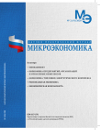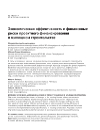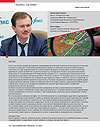The degree of provision of housing to the population of the regions of the Arctic zone of the Russian Federation
DOI: 10.33917/mic-4.123.2025.84-94
The article considers the indicators (criteria) for the implementation of national and federal projects of the Russian Federation, adopted by Presidential Decrees in 2014 and 2024, aimed at increasing the level of provision of residential premises for the population living in the Arctic Zone of the Russian Federation. The dynamics of such interrelated indicators in four regions of the Arctic Zone over a period of 10 years is analyzed as the degree of housing provision for the population; the development of housing construction, determined by the indicator; the number of economically active population.
References:
1. Babkina L.N. Skotarenko O.V. Developmental dynamics of the construction industry in the north-west region of the Russian Federation. News of universities. Investments. Construction. Real estate. 2018;2(2 (25)):18-30.
2. Klevtsov V.V., Petrova T.V. Increasing housing provision of the population on the basis of mortgage lending: theoretical and methodological aspect. Fundamental research. 2013;6-3:684-687.
3. The Ministry of Transport revealed key goals until 2030. News RSS channel Metadservice. URL: https://mc.ru/news/nw/news_id/15614
4. National project «Infrastructure for Life»: Resolution of the Federation Council of the Federal Assembly of the Russian Federation of November 27, 2024 No. 530-SF. URL:https://coiruk.nso.ru/sites/coiruk.nso.ru/wodby_files/files/page_6485/
5. On the national development goals of the Russian Federation for the period up to 2030 and for the future up to 2036: Decree of the President of the Russian Federation of May 7, 2024 No. 309. Official publication of regulatory acts. URL: http://publication.pravo.gov.ru/document/
6. Passport of the Federal Project «Housing». Ministry of Construction of Russia. 10.22.2024. URL: https://www.minstroyrf.gov.ru/docs/139874/
7. Passport of the Federal Project «New Rhythm of Construction». Ministry of Construction of Russia. 02.01.2022. URL: https://www.minstroyrf.gov.ru/docs/139873/
8. Regions of Russia. Socio-economic indicators. Federal State Statistics Service. URL: https://rosstat.gov.ru/folder/210/document/13204
9. The new National Project «Infrastructure for Life» will start in 2025. Rossiyskaya Gazeta. Special Issue: Construction No. 176 (9418). URL: https://rg.ru/2024/08/09/kak-programmu-nazovete.html
10. Tsypin A.P., Kabanova E.E., Gadzhimirzoev G.I. Statistical Analysis of Housing Provision of the Population of Russian Regions/ Bulletin of the Saratov University. New Series. Series: Economy. Management. Law. 2023;23(1):27-34.
11. Yukish V.F. Comparison of Socio-Economic Indicators in Russian Regions with the Maximum Migration Increase and the Highest Migration Loss of Population. Economy and Business. 2021;11-1 (81): 245-250.









